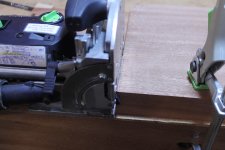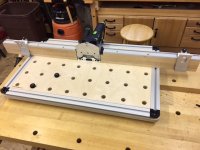I've read this thread with interest because I can't really figure out why problems with the use of the Domino are occurring. I never have any issues with alignment other than those caused by my errors or techniques. I rarely use the "paddles" on the fence for lineup, choosing instead, to merely make matching marks on the mating pieces and lining those marks up with the cursor on the Domino's window. The resulting alignment is so close that it is essentially perfect and better than I could accomplish any other way. Many times I just cut all slots at the smallest size and the alignment is still "perfect".
Based on the original poster's description of what he must do to get the alignment close, I didn't find anything that would be contrary to what is required during use. Since a lot of force is being exerted during the plunge, counter acting force must be applied to keep the Domino from moving, both vertically and horizontally.
The comparison was made to a biscuit joiner. The Domino and a biscuit joiner are two different tools and, for me, have always serve two different purposes. The Domino produces a solid, strong, and structurally sound loose tenon joint which can be used for furniture and cabinet making and replaces a traditional mortise and tenon joint. The biscuit joiner results in improved line up for gluing, but really isn't meant for strength in furniture or cabinet construction. The Domino joint is a mortise and tenon joint. The biscuit joint isn't.
I found that reading the Supplemental Manual, now available on the Festool website as a downloadable file,
provided a lot of guidance that helped me with various techniques and with operation that wasn't completely intuitive. It improved my setup and work with Domino.
Also, I assume the OP is using dust collection with the Domino since since he has experience with a biscuit joiner. Dust collection is a must with the Domino.
Not trying to be critical. For me, the Domino is a tool which has no equal in terms of quick, easy mortise and tenon joinery. All the joints are strong, fit more tightly than any standard mortise and tenon joint I ever cut, and work for unusual situations where a hand cut joint would be more difficult to make. I've never found it to be inaccurate so I would like everyone who uses it to experience the benefits of a tool which clearly makes creating furniture, cabinets, boxes, drawers, picture frames; almost anything, easier and more fun.


